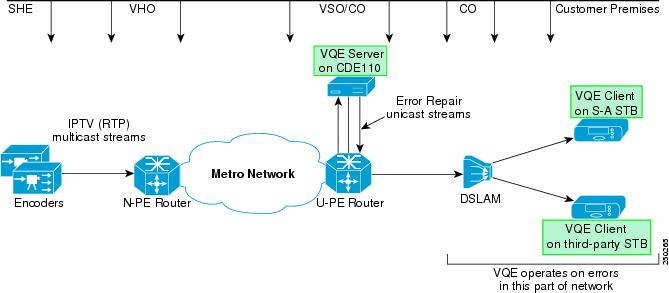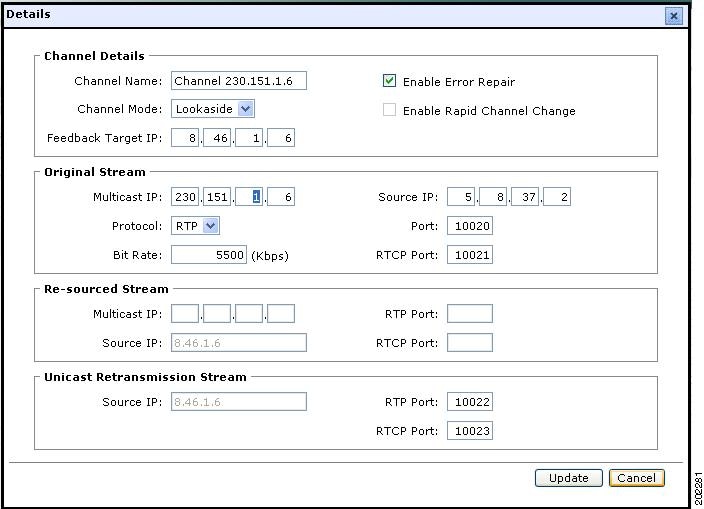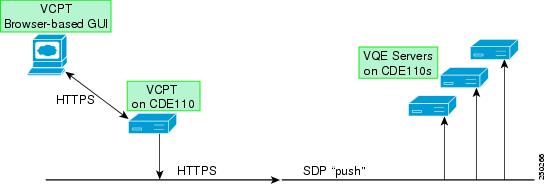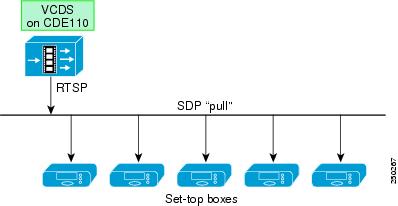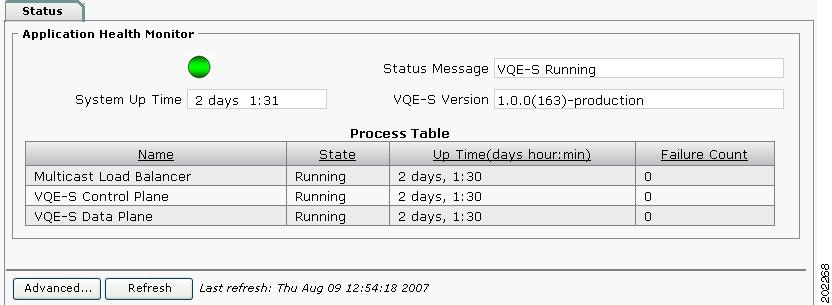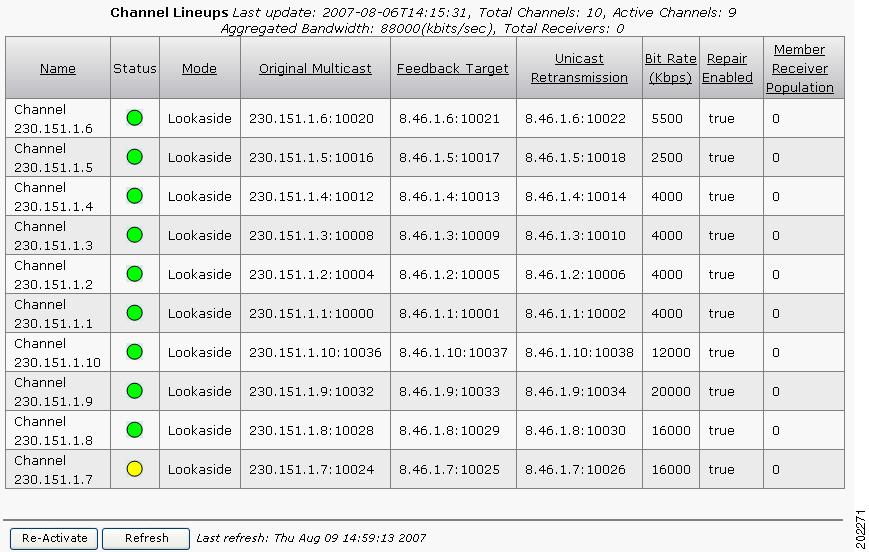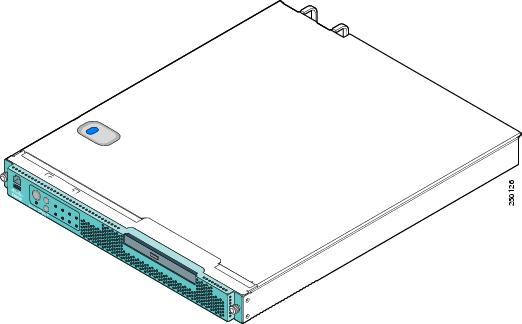

Table Of Contents
Introduction to Cisco CDA Visual Quality Experience Application
VQE Deployment Options and Requirements
VQE Reference Architecture Model
Cisco End-to-End IPTV Solution Model
VQE Channel Provisioning Tool and Channel Information
VQE-S Application Monitoring Tool
VQE-S RTCP Exporter for Video-Quality Monitoring
Introduction to Cisco CDA Visual Quality Experience Application
This chapter provides an introduction to Cisco CDA Visual Quality Experience Application (VQE), Release 2.0, and contains the following major topics:
•
VQE Deployment Options and Requirements
•
VQE Channel Provisioning Tool and Channel Information
•
VQE-S Application Monitoring Tool
•
VQE-S RTCP Exporter for Video-Quality Monitoring
VQE Overview
Cisco CDA Visual Quality Experience Application (VQE) offers service providers a set of technologies and products associated with the delivery of IPTV video services. VQE is designed to improve the quality of IPTV services and subscribers' viewing experiences. VQE is part of a Cisco end-to-end solution that builds video awareness into the network infrastructure. For Cisco VQE, Release 2.0, VQE technology is intended for wireline operators who offer managed broadcast (multicast) IPTV services using xDSL.
IPTV subscribers expect high video quality. Because many subscribers are migrating from existing analog or digital cable services, their quality expectation has already been set. To attract subscribers, IPTV providers must meet or exceed the video experience of existing services. VQE technology and products provide that capability.
Video is less tolerant of network factors such as jitter and delay. Therefore, IP networks require additional functionality to deliver the video quality expected by subscribers. The accepted industry benchmark for quality is to deliver a maximum of one video "artifact" or perceived distortion during the viewing of a one-hour movie. This level of quality translates into a network-layer requirement of less than 7.8E-7 video packets loss.
VQE addresses the issue of video quality from both a network infrastructure and a video technology perspective. VQE provides the linkage to optimize video delivery over next-generation carrier networks. Based on industry standards, including Real-Time Transport Protocol (RTP) and RTP Control Protocol (RTCP), Cisco VQE, Release 2.0, provides two mechanisms to help in delivering entertainment-grade services to subscribers:
•
Error Repair—Optimized, selective retransmission of dropped IPTV packets to repair bit errors caused by noisy DSL lines or errors in the home network caused by poor quality wiring. The subscriber does not detect the repair and no video artifact results.
•
IPTV Packet Loss Monitoring—Facilities such as VQE-S RTCP Exporter to help operators measure, baseline, and pinpoint problem areas of the video infrastructure, including transmission lines and home networks.
Figure 1-1 shows the location of the major VQE components in the service-provider network and in the subscriber's customer premises equipment (CPE).
Figure 1-1 VQE Major Components
The two major VQE software components that implement the Error Repair and IPTV Packet Loss Monitoring are:
•
VQE Client (VQE-C)—Software embedded in the subscriber's CPE—typically a set-top box. VQE-C provides the CPE interface to VQE Server to support Error Repair and IPTV Packet Loss Monitoring statistics. When VQE-C software detects packet loss, it requests a retransmission of the missing packets from VQE Server. When VQE-C receives the retransmitted packets, the missing packets are resequenced by the set-top box without interruption. A VQE Client will be integrated into selected Scientific Atlanta set-top boxes and can be integrated into set-top boxes from third-party vendors.
•
VQE Server (VQE-S)—Software that runs on a Linux-based Cisco Content Delivery Engine 110 (CDE110) appliance located in the intelligent edge of the service provider's network. Working with the VQE Client, VQE-S monitors the subscriber's reception of video packets and uses its cached video data to service Error Repair retransmission requests from VQE Client software in the set-top box.
VQE also provides two web browser-based tools: VQE Channel Provisioning Tool (VCPT) and VQE-S Application Monitoring Tool (AMT).
VQE Channel Provisioning Tool is an optional channel-provisioning utility to aid with the channel lineup configuration required by both VQE-S and VQE-C. The channel information is in Session Description Protocol (SDP) format. VQE Channel Provisioning Tool sends the channel information to the VQE Servers and VQE Client Channel Configuration Delivery Servers. The VQE Client Channel Configuration Delivery Servers provide the channel lineup to the VQE Clients on the set-top boxes.
VQE-S Application Monitoring Tool is a browser-based GUI that displays configuration, status, and statistics on the VQE-S processes, the channel lineup, Error Repair, Multicast Load Balancer, and VQE-S RTCP Exporter. VQE-S Application Monitoring Tool also allows you to configure debugging and logging facilities.
VQE relies on Real-Time Transport Protocol (RTP) and RTP Control Protocol (RTCP). RTP is used to carry video packets over multicast streams from the video head-end to the VQE Clients on the set-top boxes. It is also used to transport specific video packets between the VQE Server and a VQE Client. RTCP is a signaling protocol used between VQE devices.
RTP encapsulation is typically the responsibility of real time encoders and/or specialized video products, such as a Scientific Atlanta Digital Content Manager (DCM). These devices often reside in the video headend office (VHO) or super headend (SHE). RTP sequence numbers are assigned to IPTV packets and are unique within a given multicast group or channel.
VQE Server and VQE Channel Provisioning Tool are bundled software and hardware solutions. VQE Server and VQE Channel Provisioning Tool run on separate Cisco Content Delivery Engine 110 (CDE110) appliances. A typical network might consist of multiple CDE110s hosting VQE Server and one or two CDE110s hosting VQE Channel Provisioning Tool and VQE Client Channel Configuration Delivery Server.
The VQE-S software functions in lookaside mode where the VQE Server is not directly in the video data path. Lookaside mode has these advantages:
•
If the Cisco CDE110 appliance or VQE-S software should fail, there is no loss of IPTV service to the customer.
•
Because no multicast forwarding is provided by VQE-S, more IPTV customers can be serviced by each VQE-S instance.
•
The number of Cisco CDE110 appliances hosting VQE-S can be easily scaled up as subscriber count and the demand for VQE services increase.
The Cisco Content Delivery Engine 110 is a standalone, carrier-hardened, appliance running the Linux operating system. The Cisco CDE110 is NEBS-compliant and suitable for central office lights-out locations. The Cisco CDE110 comes with the required software pre-installed: VQE Server or VQE Channel Provisioning Tool, Linux, Apache web server, and other software.
VQE Benefits
Cisco VQE, Release 2.0, provides the following benefits to the service provider:
•
Addresses noise issues associated with lossy DSL lines and home network wiring
•
Reduces or eliminates quality-related service-center calls
•
Reduces or eliminates the need for outside plant optimization, such as pair swapping, joint renewals, and drop-cable re-runs
•
Increases addressable market consumer base because Error Repair technology enables video service over noisier transmission lines, thus extending available footprint
•
Reduces or eliminates the need to fragment video service into consumers that can and cannot receive service based on line quality attributes
•
Establishes a video quality baseline for all consumers with granularity per set-top box
•
Provides an end-to-end view of network characteristics from an IPTV delivery perspective
•
Uses open, standards-based protocols
Cisco VQE, Release 2.0, also provides the subscriber with an enhanced video experience with higher and consistent visual and audio quality. Subscribers with noisier transmission lines or longer loop lengths can take advantage of the service provider's video offerings, bundles, and unique content.
VQE Server
The VQE Server (VQE-S) software is hosted on a Cisco CDE110 appliance running a standard Linux operating system. The Cisco CDE110 comes with the required software pre-installed: VQE-S, VQE-S Application Monitoring Tool, Linux, Apache web server, and other software.
VQE-S is responsible for the following functions:
•
Creating a channel configuration database using the channel configuration information sent by the VQE Channel Provisioning Tool
•
Maintaining per-channel and per-component state information
•
Handling Error Repair by caching RTP data streams for channels and sending Error Repair packets to the requesting VQE Clients on the set-top boxes
•
Load balancing VQE-S services across the Cisco CDE110 Ethernet interfaces
•
Providing detailed statistics on IPTV delivery down to the set-top box VQE Client level
•
Monitoring the health of VQE-S application processes
Like a regular IP host, VQE-S joins multicast groups using Internet Group Management Protocol (IGMP). VQE-S maintains a dedicated buffer for each channel. VQE-S receives the multicast stream for each channel from upstream, caching a few seconds of the most recently received program content from each.
For Error Repair, when a VQE Client requests retransmission of missing packets, VQE-S locates them in its cache and, if found, delivers them to the set-top box through an associated RTP retransmission stream. A single VQE Server can process up to 10,000 inbound repair requests per second. A repair request may support up to 17 packet retransmissions in a single transaction.
A number of factors affect how many errors a single VQE Server can repair for a single VQE Client. These factors include the distribution of errors, the bandwidth of the channel, and the size of the jitter buffer in the set-top box.
The VQE-S scaling model calculates the maximum number of VQE Clients that can be supported by a single VQE-S based on variable input data including average bit error rates, peak concurrency, and so forth. Each VQE-S supports up to 10,000 VQE Clients on set-top boxes. The actual number of VQE Clients supported will vary depending on the error characteristics of the transmission lines, home wiring, and other external factors.
VQE-S provides a number of high-availability mechanisms for resiliency and redundancy:
•
The VQE-S processes (Control Plane, Data Plane, and Multicast Load Balancer) are constantly monitored by the VQE monitoring process—Process Monitor. If a VQE-S process fails, Process Monitor automatically attempts to restart it.
•
If Process Monitor itself fails, the Linux initialization process detects this failure and restarts Process Monitor.
•
If the Cisco CDE110 running VQE-S fails and there is a redundant, backup CDE110 running VQE-S that is configured to receive the same multicast streams, the backup VQE-S takes over servicing the streams.
•
The use of anycast IP addresses and equal-cost multi-path routing allows multiple VQE Servers in a single facility to be loaded balanced between servers and to provide failover protection in case of a server failure.
For Multicast Load Balancing, when a multicast stream used for caching or Error Repair starts or stops, VQE-S determines the best Cisco CDE110 Ethernet interface on which to join or leave the multicast group. The VQE-S software distributes the joins across available Ethernet interfaces to avoid oversubscription. VQE-S also monitors the status of these interfaces, moving the streams to other interfaces in case of interface failure.
VQE-S uses Linux system and network services for system initialization, network access, interface status monitoring, and multicast stream reception.
VQE Client
The VQE Client (VQE-C) software runs on customer premises equipment (CPE), such as a set-top box. VQE Client supports Error Repair and video quality statistics by providing the following:
•
CPE interface to VQE-S
•
RTP data plane jitter buffer and shaping
•
IPTV Packet Loss Monitoring
If an error in video transmission occurs, the VQE-C software detects the packet loss and requests a retransmission while holding the video sequence in queue. VQE Server automatically repairs the error by transmitting the missing packet, which is re-sequenced by the set-top box without interruption. The entire error-repair cycle is imperceptible to the viewer.
For information on the interactions between a VQE Client and a VQE Client Channel Configuration Delivery Server, see the "VQE Channel Provisioning Tool and Channel Information" section.
The VQE-C software, which resides in the set-top box, also provides the instrumentation for IPTV Packet Loss Monitoring and valuable "last hop" analysis. VQE Client will be available in two deployment models:
•
VQE Client will be integrated into selected Scientific-Atlanta set-top boxes.
•
The VQE-C code is offered through an open-source program for integration with set-top boxes from third-party vendors.
The next section, "VQE Deployment Options," provides more information on VQE-C deployment models.
VQE Deployment Options and Requirements
The two basic deployment options for VQE are as follows:
•
VQE reference architecture model—For existing IPTV deployments or new IPTV deployments that do not use Cisco/Scientific-Atlanta set-top boxes
•
Cisco end-to-end IPTV solution model—For new IPTV opportunities
With both deployment options, VQE Server is deployed on a Cisco CDE110 appliance running Linux.
VQE Reference Architecture Model
The VQE reference architecture model is designed for existing IPTV deployments or new IPTV deployments that do not use Cisco/Scientific-Atlanta set-top boxes. Cisco will offer VQE-C as open-source software. VQE-C is implemented so that service providers and CPE device vendors can integrate the VQE-C software with third-party set-top boxes. Appropriate development-level documentation is available along with the VQE-C code.
With this model, the service provider uses the VQE Channel Provisioning Tool to define channels and servers and to create channel lineups for different subscriber regions. The VQE Channel Provisioning Tool sends the channel information to the VQE Servers and to the VQE Client Channel Configuration Delivery Servers from which each VQE Client gets its channel information. The channel information is in the Session Description Protocol (SDP) format required by VQE-S and VQE Client Channel Configuration Delivery Server.
Cisco End-to-End IPTV Solution Model
The Cisco end-to-end IPTV solution model is designed for new or "greenfield" IPTV opportunities. VQE technology is included as an integral part of Cisco's end-to-end video solution.
In this model, VQE-C is integrated with selected Scientific Atlanta set-top boxes. The main difference between the Cisco end-to-end IPTV solution and the VQE reference architecture models lies with integration responsibility of VQE-C.
•
For the Cisco end-to-end IPTV solution model, Cisco and Scientific Atlanta are responsible for the integration and testing of VQE-C.
•
For the VQE reference architecture model, the third-party vendor is responsible for the integration and testing of VQE-C.
For the Cisco end-to-end IPTV solution, contact your Scientific-Atlanta or Cisco representative for details of the set-top box models and software versions supported.
VQE Deployment Requirements
To deploy VQE, the following prerequisites must be met:
•
Real-Time Transport Protocol (RTP) support—Video streams from the headend must be encapsulated in RTP. Service providers can deploy products such as the Scientific Atlanta Digital Content Manager (DCM) to provide RTP encapsulation capabilities at the video headend.
•
VQE-C and CPE integration—VQE-C must be integrated with the software of the CPE device (set-top box).
•
TV channel information—VQE-C and VQE-S require details of network-level TV channel lineup information. This includes per-channel IP multicast addresses, port numbers, and some other parameters. The information must be presented to the VQE-C and VQE-S components in Session Description Protocol (SDP) format. The VQE Channel Provisioning Tool is designed specifically for this purpose.
•
VQE-S network connectivity— VQE-S requires a connection to the edge router for the purposes of joining and receiving Internet Group Management Protocol (IGMP) multicast groups (channels). In Cisco VQE, Release 2.0, a direct, Layer-3 connection between VQE-S and the edge router is preferred.
•
VQE-C network connectivity—VQE-C requires an IP unicast path to and from its designated VQE-S. The path is used for RTP Control Protocol (RTCP) signaling between the VQE-C and VQE-S, and for sending RTP data packets from VQE-S to VQE-C.
•
All versions of IGMP are supported by VQE-S and VQE-C.
VQE Channel Provisioning Tool and Channel Information
The VQE Channel Provisioning Tool (VCPT) is responsible for the creation, maintenance, and distribution of the channel information containing channel-lineup data. VCPT includes a browser-based GUI that allows the service provider to provision the following:
•
Channel definitions—Information on the channels that will be serviced by VQE
•
Server definitions—Information on each VQE Server and VQE Client Channel Configuration Delivery Server that will receive the channel information
•
Channel lineups—Associations between channels and the VQE Servers and VQE Client Channel Configuration Delivery Servers.
Figure 1-2 shows the details that the service provider defines for each channel using VCPT.
Figure 1-2 VCPT Channel Definition
The VCPT GUI has a clone capability to simplify and expedite channel information. When the service provider uses VCPT to define the set of VQE Servers that receive the channel information, the VQE Servers can be grouped based on channel lineups. Using separate VCPT configuration files makes it possible to manage multiple deployments. For example, one VCPT configuration file might be for the channel lineup in one metro region, and another VCPT configuration file might be for the channel lineup in another metro region.
The VCPT channel-provisioning process creates a persistent local database, which is stored on the Cisco CDE110 appliance. When the Cisco CDE110 or VCPT is restarted, channel data and server grouping information is read from the local database.
When the user completes channel, server, and channel-lineup configuration and initiates the VCPT send operation, VCPT sends the channel information in Session Description Protocol (SDP) format to the set of VQE Servers and to the VQE Client Channel Configuration Delivery Server.
VCPT sends or "pushes" the channel information to all VQE Servers that are defined in the current VCPT configuration file. The channel information is sent to the VQE Servers over secure HTTPS. VCPT contains a secure HTTPS client, and each VQE Server has an embedded web server running. Each VQE Server stores it own local copy of the channel information. Figure 1-3 shows the interactions between VCPT and the VQE Servers. For information on the VQE Servers, see the "VQE Server" section.
Figure 1-3 VCPT: Sending Channel Information to VQE Servers
VQE Client Channel Configuration Delivery Server is a software component installed on the Cisco CDE110 that hosts VCPT. When the user initiates the VCPT send operation, VCPT "pushes" the channel information to the VQE Client Channel Configuration Delivery Servers. VCPT sends the channel information in SDP format through HTTPS similar to the way it is sent to the VQE Servers.
Each VQE Client running in a CPE device, such as a set-top box, uses a Real Time Streaming Protocol (RTSP) "pull" operation to receive the channel information. The VQE Client learns the name of the VQE Client Channel Configuration Delivery Server through a Domain Name System (DNS) server. After the VQE Client learns the VQE Client Channel Configuration Delivery Server name, it sends out an RTSP DESCRIBE request, asking for information on channels. The VQE Client Channel Configuration Delivery Server sends the channel configuration data for the entire channel set in SDP format. Figure 1-4 shows the interaction between a VQE Client Channel Configuration Delivery Server (VCDS) and the VQE Clients on the subscriber set-top boxes.
Figure 1-4 VQE-C on Set-Top Box: Receiving Channel Information from VCDS
VQE-S Application Monitoring Tool
The VQE-S Application Monitoring Tool (VQE-S AMT or AMT) is a browser-based GUI that allows the service-provider operator to do the following:
•
Monitor the health of the VQE-S processes
•
View channel configuration details, status, and statistics
•
Monitor statistics for Error Repair
•
View configuration details, status, and statistics for
–
Multicast Load Balancer
–
VQE-S RTCP Exporter
•
Configure VQE-S logging levels and debugging options
The next paragraphs provide a few examples of VQE-S AMT functionality.
When you log in to VQE-S AMT, the initial window (Figure 1-5) shows the health of VQE-S processes and other status information.
Figure 1-5 Monitoring VQE-S Processes
With VQE-S AMT, you can view the channel lineup that was sent from the VQE Channel Provisioning Tool. Figure 1-6 shows an example of the channel lineup with usage statistics that VQE-S AMT displays.
Figure 1-6 Viewing Channel Lineups with Usage Statistics
In Figure 1-6, the channel-lineup summary data indicates when the lineup was last updated (for example, with VCPT) and provides totals for all channels and active channels as well as aggregated bandwidth and total receivers:
Last update: 2007-08-06T14:15:31, Total Channels: 10, Active Channels: 9 Aggregated Bandwidth: 88000 (kbits/sec), Total Receivers: 0In the channel-lineup summary data, the rightmost column, Member Receiver Population, is the number of VQE Clients that are currently receiving this multicast stream.
VQE-S AMT uses the Error Repair counters kept by the VQE Server to display a variety of data on Error Repair: NACK messages received from VQE Clients, RTP packets requested and sent, and Error Repair rates.
For Cisco VQE, Release 2.0, AMT provides limited configuration capabilities. The items that can be configured with AMT include parameters for the following:
•
Logging priority level for VQE-S processes
•
Debugging options for VQE-S-related functions, including RTP/RTCP packets, events, and errors
The VQE Server channel lineup is stored locally on the Cisco CDE110 appliance. If VQE-S is restarted, the channel lineup is read from the local repository. The VQE-S counters for statistics that AMT displays are reset to zero when VQE-S is restarted.
VQE-S AMT is a web application that uses the application server and web server that are pre-installed on the Cisco CDE110 where VQE-S runs. VQE-S AMT has an XML-RPC client that communicates with multiple internal applications, such as VQE-S processes, to send and receive application management data.
VQE-S RTCP Exporter for Video-Quality Monitoring
VQE-S provides a variety of data for monitoring IPTV packet delivery and for fault isolation. VQE-S receives RTCP reports from VQE Clients on the CPE devices and from reports generated by the VQE-S itself. VQE Clients generate RTP statistics for packet loss, jitter, delay, and other quality measurements.
For the RTCP reports, VQE Clients transmit RTCP compound packets to their target VQE-S. Each compound packet contains an RTCP receiver report as well as other information. The VQE Clients send compound packets with RTCP receiver reports periodically and every time an Error Repair retransmission request is made. VQE-S also generates RTCP sender and receiver reports.
The service provider can use VQE-S RTCP Exporter to export the RTCP compound packets to a video-quality monitoring (VQM) application. The VQM application can collect the exported data in a database for use in video-quality analysis.
VQE-S RTCP Exporter is responsible for sending the RTCP compound packets to an external device, which typically hosts the video-quality monitoring application. The compound packets are sent over a TCP socket to a configurable location. The monitoring application is identified by IP address or Internet domain name and a TCP port number.
The data in the RTCP compound packets are very useful for determining the quality of video service and for isolating faults. The data help the service provider to measure, baseline, and pinpoint problem areas of the video infrastructure including transmission lines and home networks. The granularity of the data is per set-top box. The data could be stored in a database and searched for answers to questions of interest, such as whether packet loss and jitter events have occurred in the network and, if so, where and when have the events occurred.
The video-quality monitoring application is outside the scope of the VQE solution. The VQE documentation set includes detailed information on the data collected and the formats used in the RTCP reports. RTCP reports are described in RFC-3550.
Content Delivery Engine 110
Each VQE Server runs on one Cisco Content Delivery Engine 110 (CDE110). If VQE Channel Provisioning Tool and VQE Client Channel Configuration Deliver Server are used, another Cisco CDE110 hosts these two facilities. The Cisco CDE110 (Figure 1-7) comes with the Red Hat Enterprise Linux 5.0 operating system and either the VQE-S or VCPT and VQE Client Channel Configuration Deliver Server software pre-installed.
Figure 1-7 Content Delivery Engine 110
The Cisco CDE110 appliance is a NEBS-3 and ETSI-compliant carrier-grade rack server. It is powered by two 64-bit Dual-Core Intel Xeon processor LV 5148 processors. For maximized bandwidth, it contains 4 GB of dual-channel Fully Buffered DIMM (FB-DIMM) memory at 667 MHz. For storage, the Cisco CDE110 has one 36-GB simple-swap, serial attached SCSI (SAS) hard disk drive. The optical drive is a CD/DVD RW combination drive.
The Cisco CDE110 has four integrated 10/100/1000 Mb Ethernet ports and a serial port for the system console. The Ethernet ports can be load-balanced for incoming multicast IPTV streams and for outgoing Error Repair unicast streams to the VQE Clients.
The Cisco CDE110 has a 1-RU form factor and is available with redundant AC or DC hot-swappable power supplies. The Cisco CDE110's Telco Alarm Management features provide visual, audible (optional) and SNMP event indications of faults, consistent with the rigid requirements of the telecom central office environment.
For complete information on the Cisco CDE110, see the Cisco Content Delivery Engine 110 Hardware Installation Guide.

 Feedback
Feedback